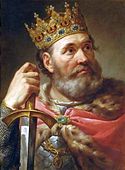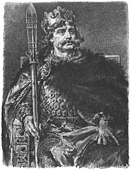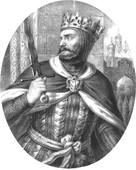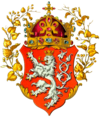Bolesław I the Brave
| Bolesław I the Brave | |
|---|---|
Dobrawa of Bohemia | |
| Religion | Chalcedonian Christianity |
Bolesław I the Brave
The son of
At the
Bolesław is widely considered one of Poland's most accomplished
Early life
Bolesław was born in 966 or 967,
Bolesław's mother, Dobrawa, died in 977; his widowed father married
Accession and consolidation

Mieszko I died on 25 May 992.[13][14] The contemporaneous Thietmar of Merseburg recorded that Mieszko left "his kingdom to be divided among many claimants", but Bolesław unified the country "with fox-like cunning"[15] and expelled his stepmother and half-brothers from Poland.[16][17] Two Polish lords Odilien and Przibiwoj,[18] who had supported her and her sons, were blinded on Bolesław's order.[17] Historian Przemysław Wiszewski says that Bolesław had already taken control of the whole of Poland by 992;[19] Pleszczyński writes that this only happened in the last months of 995.[16]
Bolesław's first coins were issued around 995.
Soběslav, the head of the Bohemian Slavník dynasty, also participated in the 995 campaign.[26] Taking advantage of Soběslav's absence, Boleslav II of Bohemia invaded the Slavníks' domains and had most members of the family murdered.[27] After learning of his kinsmen's fate, Soběslav settled in Poland.[16][28] Bolesław gave shelter to him "for the sake of [Soběslav's] holy brother",[29] Bishop Adalbert of Prague, according to the latter's hagiographies.[30] Adalbert (known as Wojciech before his consecration)[31] also came to Poland in 996, because Bolesław "was quite amicably disposed towards him".[30][32] Adalbert's hagiographies suggest that the bishop and Bolesław closely cooperated.[33] In early 997 Adalbert left Poland to proselytise among the Prussians, who had been invading the eastern borderlands of Bolesław's realm.[24][33] However, the pagans murdered him on 23 April 997.[33] Bolesław ransomed Adalbert's remains, paying its weight in gold, and buried it in Gniezno.[9][33][34] He sent parts of the martyr bishop's corpse to Emperor Otto III who had been Adalbert's friend.[34]
Congress of Gniezno and its aftermath (999–1002)

Emperor Otto III held a synod in Rome where Adalbert was canonised on the emperor's request on 29 June 999.
Bolesław took advantage of the emperor's pilgrimage.
Gallus Anonymus claimed that Bolesław was "gloriously raised to kingship by the emperor"
If anyone in this land should presume to abuse a foreign matron and thereby commit fornication, the act is immediately avenged through the following punishment. The guilty party is led on to the market bridge, and his scrotum is affixed to it with a nail. Then, after a sharp knife has been placed next to him, he is given the harsh choice between death or castration. Furthermore, anyone found to have eaten meat after Septuagesima is severely punished, by having his teeth knocked out. The law of God, newly introduced in these regions gains more strength from such acts of force than from any fast imposed by the bishops
— Thietmar of Merseburg: Chronicon[51]
During the time the Emperor spent in Poland, Bolesław also showed off his affluence.
After the meeting, Bolesław escorted Otto III to Magdeburg in Germany where "they celebrated Palm Sunday with great festivity"[53] on 25 March 1000.[54] A continuator of the chronicle of Adémar de Chabannes recorded, decades after the events, that Bolesław also accompanied Emperor Otto from Magdeburg to Aachen where Otto III had Charlemagne's tomb reopened and gave Charlemagne's golden throne to Bolesław.[49][55][56]
An illustrated Gospel, made for Otto III around 1000, depicted four women symbolising Roma, Gallia, Germania and Sclavinia as doing homage to the Emperor who sat on his throne.
Coins struck for Bolesław shortly after his meeting with the emperor bore the inscription Gnezdun Civitas, showing that he regarded Gniezno as his capital.[55] The name of Poland was also recorded on the same coins referring to the Princes Polonie [sic].[55] The title princeps was almost exclusively used in Italy around that time, suggesting that it also represented the Emperor's idea of the renewal of the Roman Empire.[55] However, Otto's premature death on 23 January 1002 put an end to his ambitious plans.[54] The contemporaneous Bruno of Querfurt stated that "nobody lamented" the 22-year-old emperor's "death with greater grief than Bolesław".[58][59]
In 1000 Bolesław issued a law prohibiting hunting beavers[60] and created a office called "Bobrowniczy"[61] whose task was to enforce prince's ordinances.[62]
Expansion (1002–1018)

Three candidates were competing with each other for the German crown after Otto III's death.

Duke
King Henry allied himself with the pagan Lutici,[74] and broke into Lusatia in February 1004, but heavy snows forced him to withdraw.[71][76] He invaded Bohemia in August 1004, taking the oldest brother of the blinded Boleslaus III of Bohemia, Jaromír, with him.[76] The Bohemians rose up in open rebellion and murdered the Polish garrisons in the major towns.[76] Bolesław left Prague without resistance, and King Henry made Jaromír duke of Bohemia on 8 September.[76] Bolesław's ally Soběslav died in this campaign.[74]
During the next part of the offensive King Henry retook
In 1007, after learning about Bolesław's efforts to gain allies among Saxon nobles and giving refuge to the deposed duke of Bohemia,

In 1014, Bolesław sent his son Mieszko to Bohemia in order to form an alliance with Duke
Later that year, Bolesław's son Mieszko was sent to plunder
War in Kiev (1018)
Bolesław organised his first expedition east, to support his son-in-law
Last years (1019–1025)
Historians dispute the exact date of Bolesław's
Wipo of Burgundy in his chronicle describes the event:
[In 1025] Boleslaus [of the Slavic nation], duke of the Poles, took for himself in injury to King Conrad the regal insignia and the royal name. Death swiftly killed his temerity.
It is widely believed that Bolesław had to receive permission for his coronation from the newly-elected Pope John XIX.[105] John was known to be corrupt, and it is likely that consent was or may have been obtained through bribes.[106] However, Rome also hoped for a potential alliance to defend itself from Byzantine Emperor Basil II, who launched a military expedition to recover the island of Sicily and could subsequently threaten the Papal States from the south.[106] Stanisław Zakrzewski put forward the theory that the coronation had the tacit consent of Conrad II and that the pope only confirmed that fact.[107] That is corroborated by Conrad's confirmation of the royal title to Mieszko II, his agreement with the counts of Tusculum and the papal interactions with Conrad and Bolesław.[108]
Death and burial

According to
The medieval sarcophagus was partially damaged on 30 September 1772 during a fire, and completely destroyed in 1790 due to the collapse of the southern tower.[113] Bolesław's remains were subsequently excavated from the rubble and moved to the cathedral's chapter house.[113] Three bone fragments were donated to Tadeusz Czacki in 1801, at his request.[113] Czacki, a notable Polish historian, pedagogue, and numismatist, placed one of the bone fragments in his ancestral mausoleum in Poryck (now Pavlivka) in the Volhynia region; the other two were given to Princess Izabela Flemming Czartoryska, who placed them in her recently founded Czartoryski Museum in Puławy.
After many historical twists, the burial place of Bolesław I ultimately remained at Poznań Cathedral, in the Golden Chapel.[114] The content of his epitaph is known to historians. It is Bolesław's epitaph, which, in part, came from the original tombstone, that is one of the first sources (dated to the period immediately after Bolesław's death, probably during the reign of Mieszko II)[115] that gave the King his widely known nickname of "Brave" (Polish: Chrobry). Later, Gallus Anonymus, in Chapter 6 of his Gesta principum Polonorum, named the Polish ruler as Bolezlavus qui dicebatur Gloriosus seu Chrabri.
Family


The contemporaneous
Bolesław "took a Hungarian woman"[18] as his second wife.[116] Most historians identify her as a daughter of the Hungarian ruler Géza, but this theory has not been universally accepted.[118] She gave birth to a son, Bezprym, but Bolesław repudiated her.[116]
Bolesław's third wife,
Bolesław's fourth marriage, from 1018 until his death, was to
Predslava, a daughter of
Marriages and Issue:
Oda/Hunilda?, daughter of Rikdag
Unknown Hungarian woman (sometimes identified as Judith of Hungary):
- Bezprym (c. 986–1032) – became Duke of Poland
Emnilda, daughter of Dobromir:
- Unknown abbess of an unidentified abbey
- Regelinda (c. 989 – 21 March aft. 1014), married Herman I, Margrave of Meissen becoming Margravine of Meissen
- Mieszko II Lambert (c. 990 – 10/11 May 1034), became king and subsequent to his dethronement, regained power as duke of Poland
- Unknown daughter, married Grand Prince Sviatopolk I of Kiev and became Grand Princess of Kiev
- Otto Bolesławowic (c. 1000–1033)
- Matilda (c. 1018–1036), betrothed to Otto of Schweinfurt but the marriage was rejected.
Gallery
-
Portrait of Boleslaus I the Brave byMarcello Baciarelli, c. 1770
-
Boleslaus I of Poland, a drawing by Jan Matejko, c. 1890
-
Boleslaus I the Brave by Aleksander Lesser
-
Boleslaus on a postage stamp, 1938
See also
- Bolesław Chrobry Tournament – speedway event named after the King
- Castle Chrobry in Szprotawa
- Crown of Bolesław I the Brave
- History of Poland (966–1385)
Notes
References
- ^ A. Czubinski, J. Topolski, Historia Polski, Ossolineum, 1989.[ISBN missing][page needed]
- ISBN 83-04-00148-9. p. 248
- ^ a b c d e f Wiszewski 2010, p. xliii.
- ^ a b Vlasto 1970, p. 115.
- ^ Wiszewski 2010, pp. 57, 60.
- ^ a b c Wiszewski 2010, p. 63.
- ^ Barford 2001, p. 163.
- ^ a b Manteuffel 1982, p. 51.
- ^ a b c d e Barański 2008, pp. 51, 60–68.
- ^ Manteuffel 1982, p. 52.
- ^ Wiszewski 2010, pp. xliii, 35.
- ^ Wiszewski 2010, pp. 8–9.
- ^ Manteuffel 1982, p. 55.
- ^ Wiszewski 2010, p. xlii.
- ^ The Chronicon of Thietmar of Merseburg (ch. 4.58.), p. 192.
- ^ a b c Pleszczyński 2001, p. 417.
- ^ a b Manteuffel 1982, pp. 56–57.
- ^ a b c d e f The Chronicon of Thietmar of Merseburg (ch. 4.58.), p. 193.
- ^ Wiszewski 2010, p. xxxvii.
- ^ Berend, Urbańczyk & Wiszewski 2013, p. 145.
- ^ Berend, Urbańczyk & Wiszewski 2013, pp. 144–145.
- ^ a b c Pleszczyński 2001, p. 416.
- ^ a b Manteuffel 1982, p. 56.
- ^ a b Vlasto 1970, p. 125.
- ^ Vlasto 1970, pp. 124–125.
- ^ Manteuffel 1982, p. 57.
- ^ Manteuffel 1982, pp. 57–58.
- ^ Manteuffel 1982, p. 58.
- ^ Life of Saint Adalbert Bishop of Prague and Martyr (ch. 25.), p. 165.
- ^ a b Wiszewski 2010, p. 13.
- ^ Barford 2001, p. 255.
- ^ Life of Saint Adalbert Bishop of Prague and Martyr (ch. 26.), p. 167.
- ^ a b c d e Manteuffel 1982, p. 60.
- ^ a b Vlasto 1970, pp. 104–105.
- ^ a b Vlasto 1970, p. 105.
- ^ a b Manteuffel 1982, p. 61.
- ^ a b c Barford 2001, p. 264.
- ^ Vlasto 1970, pp. 125–126.
- ^ The Chronicon of Thietmar of Merseburg (ch. 4.45.), p. 183.
- ^ a b c d e f Pleszczyński 2001, p. 419.
- ^ The Deeds of the Princes of the Poles (ch. 6.), p. 35.
- ^ a b c Thompson 2012, p. 21.
- ^ Zamoyski 1987, p. 14.
- ^ The Chronicon of Thietmar of Merseburg (ch. 5.10.), p. 212.
- ^ a b c Manteuffel 1982, p. 62.
- ^ a b c The Deeds of the Princes of the Poles (ch. 6.), p. 37.
- ^ a b The Deeds of the Princes of the Poles (ch. 6.), p. 39.
- ^ Berend, Urbańczyk & Wiszewski 2013, p. 121.
- ^ a b c d Pleszczyński 2001, p. 420.
- ^ Berend, Urbańczyk & Wiszewski 2013, p. 122.
- ^ The Chronicon of Thietmar of Merseburg (ch. 8.2), p. 362.
- ^ The Chronicon of Thietmar of Merseburg (ch. 4.46.), p. 184.
- ^ The Chronicon of Thietmar of Merseburg (ch. 4.46.), p. 185.
- ^ a b Manteuffel 1982, p. 63.
- ^ a b c d e f Vlasto 1970, p. 127.
- ^ Zamoyski 1987, p. 13.
- ^ a b Strzelczyk 2003, p. 24.
- ^ Life of the Five Brethren by Bruno of Querfurt (ch. 8.), p. 237.
- ^ Pleszczyński 2001, p. 421.
- ^ "Ciekawostki o bobrze". puszcza.tv (in Polish). Retrieved 28 July 2021.
- ^ "bobrowniczy - Encyklopedia Leśna". www.encyklopedialesna.pl. Retrieved 28 July 2021.
- ^ "Bobry to skryte, ale bardzo ciekawe zwierzęta". Lasy Państwowe (in Polish). Retrieved 28 July 2021.
- ^ a b c Manteuffel 1982, p. 64.
- ISBN 83-04-00148-9. p. 250
- ^ Manteuffel 1982, pp. 64–65.
- ^ The Chronicon of Thietmar of Merseburg (ch. 5.9.), p. 211.
- ^ Thompson 2012, pp. 21–22.
- ^ a b c d e f Manteuffel 1982, p. 65.
- ^ a b c Reuter 2013, p. 260.
- ^ Třeštík 2011, p. 78.
- ^ a b c Berend, Urbańczyk & Wiszewski 2013, p. 142.
- ^ The Chronicon of Thietmar of Merseburg (ch. 5.30.), p. 225.
- ^ a b Manteuffel 1982, p. 66.
- ^ ISBN 83-04-00148-9. p. 251
- ^ Manteuffel 1982, pp. 66–67.
- ^ a b c d e f Manteuffel 1982, p. 67.
- ISBN 963-04-2913-6.
- ^ a b c Thietmar of Merseburg, Thietmari merseburgiensis episcopi chronicon, 1018
- OCLC 43087092
- ^ "Bitwa pod Ciani, bo nie chce mi się". Archived from the original on 19 April 2017. Retrieved 18 April 2017.
- ^ Olszowski, Michał. "historycy.org -> Bolesław Chrobry – 'pan na Morawach'". Retrieved 18 April 2017.
- ^ "Czy Bolesław Chrobry podbił Słowację?". 28 February 2011. Retrieved 18 April 2017.
- ^ Thietmar 2001, VIII, pp. 19, 61.
- ^ Thietmar 2001, VIII, p. 9.
- ^ Zajączkowski, Grzegorz. "Włącz Polskę- Polska-szkola.pl". Retrieved 18 April 2017.
- ^ "Bolesław Chrobry: legalny władca Czech czy uzurpator – Czasopisma – Onet.pl Portal wiedzy". Archived from the original on 19 April 2017. Retrieved 18 April 2017.
- ^ Michael Schmidt. "Digitales historisches Ortsverzeichnis von Sachsen". Hov.isgv.de. Retrieved 12 January 2013.
- ISBN 3-86596-015-4
- ^ ISBN 83-04-00148-9. p. 252
- ^ R.Jaworski,Wyprawa Kijowska Chrobrego, 2006
- ^ Cross, Samuel Hazzard; Sherbowitz-Wetzor, Olgerd, eds. The Russian Primary Chronicle: Laurentian Text, 1953
- ^ Anonymous Gaul,Cronicae et gesta ducum sive principum Polonorum
- ^ Wyprawa Kijowska Chrobrego Chwała Oręża Polskiego Nr 2. Rzeczpospolita and Mówią Wieki. Primary author Rafał Jaworski. 5 August 2006. p. 10
- ^ a b c Wyprawa Kijowska Chrobrego Chwała Oręża Polskiego Nr 2. Rzeczpospolita and Mówią Wieki. Primary author Rafał Jaworski. 5 August 2006. p. 11
- ^ Grabski 1964, p. 287.
- ^ Urbańczyk 2017, pp. 311–313.
- ^ Urbańczyk 2017, pp. 311–312.
- ^ Urbańczyk 2017, pp. 308–309.
- ^ Manteuffel 1982, p. 75.
- ^ Tadeusz Wojciechowski: Szkice historyczne jedynastego wieku, ed. III. 1951, p. 153.
- ^ Grabski 1964, p. 291.
- ^ Urbańczyk 2017, p. 311.
- ^ Schwarzenberg & Hucek 1994, p. 19.
- ^ The Deeds of Conrad II (Wipo) (ch. 9.), p. 75.
- ^ Urbańczyk 2017, pp. 309–310.
- ^ a b Urbańczyk 2017, p. 310.
- ^ Sochacki 2003, p. 80.
- ^ Wipo: Gesta Chuonradi II imperatoris, p. 34.
- ^ Wolverton 2009, p. 104.
- ^ Urbańczyk 2017, p. 312.
- ^ Wiszewski 2010, pp. 471–472.
- ^ Wiszewski 2010, p. 56.
- ^ a b c Nungovitch 2019, p. 98.
- ^ Michał Rożek, Adam Bujak: Nekropolie królów i książąt polskich, Warsaw 1988, pp. 12–14.
- ^ Przemysław Wiszewski: Domus Bolezlai. W poszukiwaniu tradycji dynastycznej Piastów (do około 1138 roku), Wrocław 2008, p. 62.
- ^ a b c d e f g Wiszewski 2010, p. 39.
- ^ Manteuffel 1982, p. 53.
- ^ Wiszewski 2010, p. 376.
- ^ Wiszewski 2010, p. XLIII.
- ^ Manteuffel 1982, pp. 77–78.
Sources
Primary sources
- "Life of the Five Brethren by Bruno of Querfurt (Translated by Marina Miladinov)" (2013). In Saints of the Christianization Age of Central Europe (Tenth-Eleventh Centuries) (Edited by Gábor Klaniczay, translated by Cristian Gaşpar and Marina Miladinov, with an introductory essay by Ian Wood) [Central European Medieval Texts, Volume 6.]. Central European University Press. pp. 183–314. ISBN 978-615-5225-20-8.
- "Life of Saint Adalbert Bishop of Prague and Martyr (Translated by Cristian Gaşpar)" (2013). In Saints of the Christianization Age of Central Europe (Tenth-Eleventh Centuries) (Edited by Gábor Klaniczay, translated by Cristian Gaşpar and Marina Miladinov, with an introductory essay by Ian Wood) [Central European Medieval Texts, Volume 6.]. Central European University Press. pp. 77–182. ISBN 978-615-5225-20-8.
- Ottonian Germany: The Chronicon of Thietmar of Merseburg (Translated and annotated by David A. Warner) (2001). Manchester University Press. ISBN 0-7190-4926-1.
- "The Deeds of Conrad II (Wipo)" (2000). In Imperial Lives & Letters of the Eleventh Century (Translated by Theodor E. Mommsen and Karl F. Morrison, with a historical introduction and new suggested readings by Karl F. Morrison, edited by Robert L. Benson). Columbia University Press. pp. 52–100. ISBN 978-0-231-12121-7.
- The Deeds of the Princes of the Poles (Translated and annotated by Paul W. Knoll and Frank Schaer with a preface by Thomas N. Bisson) (2003). CEU Press. ISBN 963-9241-40-7.
Secondary sources
- Barański, Marek Kazimierz (2008). Dynastia Piastów w Polsce [The Piast Dynasty in Poland] (in Polish). Wydawnictwo Naukowe PWN. ISBN 978-83-01-14816-4.
- Barford, P. M. (2001). The Early Slavs: Culture and Society in Early Medieval Eastern Europe. Cornell University Press. ISBN 0-8014-3977-9.
- Berend, Nora; Urbańczyk, Przemysław; Wiszewski, Przemysław (2013). Central Europe in the High Middle Ages: Bohemia, Hungary and Poland, c. 900–c. 1300. Cambridge University Press. ISBN 978-0-521-78156-5.
- Davies, Norman (2005). God's Playground: A History of Poland, Volume I: The Origins to 1795 (Revised Edition). Columbia University Press. ISBN 978-0-231-12817-9.
- Grabski, Andrzej Feliks (1964). Bolesław Chrobry: zarys dziejów politycznych i wojskowych (in Polish). Warszawa (Warsaw): Wyd. Minist. Obrony Narodowej. OCLC 313427345.
- Manteuffel, Tadeusz (1982). The Formation of the Polish State: The Period of Ducal Rule, 963–1194 (Translated and with an Introduction by Andrew Gorski). Wayne State University Press. ISBN 0-8143-1682-4.
- Nungovitch, Petro Andreas (2019). Here All Is Poland: A Pantheonic History of Wawel, 1787–2010. Lanham: Lexington Books (Rowman & Littlefield Publishing Group). ISBN 978-1-498-56913-2.
- Pleszczyński, Andrzej (2001). "Poland as an ally of the Holy Ottonian Empire". In Urbańczyk, Przemysław (ed.). Europe around the Year 1000. Wydawnictwo DIG. pp. 409–425. ISBN 83-7181-211-6.
- Reuter, Timothy (2013). Germany in the Early Middle Ages, c. 800–1056. Routledge. ISBN 978-0-582-49034-5.
- Rosik, Stanisław (2001). Bolesław Chrobry i jego czasy [Bolesław the Brave and his Times] (in Polish). Wydawnictwo Dolnośląskie. ISBN 978-83-70-23888-9.
- Schwarzenberg, Karl; Hucek, Miroslav (1994). The Prague Castle and Its Treasures. New York: Vendome Press. ISBN 978-0-865-65952-0.
- Sochacki, Jarosław (2003). Stosunki publicznoprawne między państwem polskim a Cesarstwem Rzymskim w latach 963–1102 (in Polish). Słupsk: Wydawnictwo Pomorskiej Akademii Pedagogicznej. ISBN 978-8-388-73171-6.
- Strzelczyk, Jerzy (2003). "Die Anfänge Polens und Deutschlands". In Lawaty, Andreas; Orłowski, Hubert (eds.). Deutsche und Polen: Geschichte-Kultur-Politik (in German). Verlag C. H. Beck. pp. 16–25. ISBN 978-3-406-49436-9.
- Thompson, James Westfall (2012). "Medieval German expansion in Bohemia and Poland". In Berend, Nóra (ed.). The Expansion of Central Europe in the Middle Ages. Ashgate Variorum. pp. 1–38. ISBN 978-1-4094-2245-7.
- Třeštík, Dušan (2011). "Great Moravia and the beginnings of the stte (9th and 10th centuries)". In Pánek, Jaroslav; Tůma, Oldřich (eds.). A History of the Czech Lands. Charles University in Prague. pp. 65–79. ISBN 978-80-246-1645-2.
- Urbańczyk, Przemysław (2017). Bolesław Chrobry – lew ryczący (in Polish). Toruń: Wydawnictwo Naukowe Uniwersytetu Mikołaja Kopernika. ISBN 978-8-323-13886-0.
- Vlasto, A. P. (1970). The Entry of the Slavs into Christendom: An Introduction to the Medieval History of the Slavs. Cambridge University Press. ISBN 978-0-521-10758-7.
- Wiszewski, Przemysław (2010). Domus Bolezlai: Values and Social Identity in Dynastic Traditions of Medieval Poland (c. 966–1138). Brill. ISBN 978-90-04-18142-7.
- Wolverton, Lisa (2009). The Chronicle of the Czechs. Washington D.C.: Catholic University of America Press. ISBN 978-0-813-21713-0.
- Zamoyski, Adam (1987). The Polish Way: A Thousand-year History of the Poles and their Culture. Hippocrene Books. ISBN 0-7818-0200-8.
External links
 Media related to Boleslaus I of Poland at Wikimedia Commons
Media related to Boleslaus I of Poland at Wikimedia Commons





